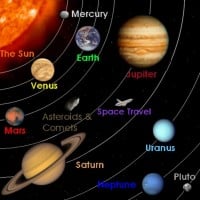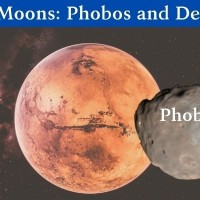Top 10 Coolest Facts about the Planet Mars
Mars, the red planet named after the Roman God of War (Greek form: Ares) is the planet that most resembles earth out of all the planets in our solar system (although there are a few planets outside of our solar system that are more like earth than Mars is). Anyway, here are some cool facts about Mars.
You know that Mount Everest is the largest mountain on earth (at 29,032 feet), but Olympus Mons is more than twice that size, at roughly 72,000 feet, Olympus Mons is over two and a half times larger than Mount Everest. Technically speaking, Olympus Mons is a volcano, but it is considered both a mountain and a volcano, by experts. Olympus Mons is so enormous that people in the 19th century were able to see it through telescopes. I guess that's why it's called "Olympus" Mons. Going with the whole Greco-Roman theme that just about everything in our solar system, but the earth itself has, it makes sense to compare it to the mountain that Greek and Roman gods lived on in mythology.

Mars is to our solar system what Texas is to the United States: everything's bigger on Mars. The largest canyon in our solar system is this canyon called "Valles Marineris", and it stretches about 4,000 kilometers or about 2,486 miles. It's long enough to go from coast to coast in the United States. Valles Marineris is also 800 kilometers wide, or about 498 miles wide. It's also 8 kilometers or 5 miles deep. In comparison, the Grand Canyon is 277 miles long, four to eighteen miles wide, and exactly 2,600 feet deep.
Well, I hiked down the Grand Canyon, but I guess I have to go hike this if I want to stay cool.

There was evidence for the existence of water on Mars long before NASA discovered that there is liquid water on the Red Planet. Several spacecraft observed channels grooved into the terrain that could have only been dug by a course of water.
More than that, it's been known for a long time that the liquid of vitality (water) resides at Mars' two poles, except it's in concrete, frozen form. I'm sure that people who want to colonize Mars are thrilled to hear this.
I wonder if millions of years ago, water might have been flowing on Mars, maybe when the planet's temperature was higher?

Mars has blue sunsets and sunrises and it's because of its atmosphere. In 1976, NASA's Viking 1 Mars lander became the first to witness blue sunsets. In contrast to the red and yellow hues that dominate the sky during sunset on Earth, on Mars, you are going to see a much bluer color.
The blue sunsets on Mars look really beautiful in this picture. I would actually really like to travel to Mars just to see a blue sunset which is glowing with light blue light. In fact, Planet Mars has some very elegant looking features according to this list.

Here's how this will happen: currently, Mars has two moons. Phobos and Deimos, the War god's sons, the gods of fear and terror. Phobos is slow to complete an orbit around Mars, so it will eventually get destroyed by gravity (not anytime soon, millions of years from now). Once Phobos is destroyed, Mars's gravitational pull will bring the debris to the red planet, and the outer layers will create a ring that can last for up to one hundred million years.
Interesting. That would make Mars the fifth planet in our solar system to have rings.

Researchers say that Mars would be the perfect place to harvest asparagus and turnips. It's good to know that if we somehow destroy the earth (but land on Mars beforehand), harvesters of turnips and asparagus will live life to the fullest on Mars. Agriculture has a bright future on the Red Planet.
So, I guess that's how aliens (or ETs... as all the Lovato stans like to call them) survive on mars.

The gravitational force to which a planet is subject. Earth has much more mass than Mars. Therefore, the sun pulls on it with greater force, because of the greater mass. You probably are familiar that gravity is a downward force. It pushes you back to the Earth's surface. This is why when you jump, you come back down. Being that the Earth has greater gravitational force, it pulls objects downward with greater force. This translates into a greater weight on earth than on Mars.
Unfortunately, it's also one of the biggest hinders for a permenant settlement on Mars, without suits

A year on Mars is 686.98 earth days. This is due to the fact that Mars is significantly farther from the Sun (152.58 million miles to earth's
92.963 million miles) and its orbital period is almost twice as long as Earth's (Earth is 365 days, excluding leap years, whereas Mars' orbital period is 687 days).
So that means that Martians don't get to celebrate their birthday as often as Earthlings do.
Because it's further to the sun than the Earth.

When the ancient Babylonians first created the week and divided it into seven days, they named each day of the week upon the seven known bodies in the sky: the Sun (hence it's Sunday), the Moon (Moon day), Mars, Mercury, Venus, Jupiter, and Saturn (Saturday Saturn Day). Hence, Tuesday is the day of Mars.
I know this thanks to French, where it's "Mardi". Similarly are Wednesday, Thursday and Friday more obviously named in French after the planets

Over 61,000 pieces of martian debris have been found on the surface of Earth. These pieces are referred to as "martian meteorites", and technically end up here due to the impact between Mars and asteroids that crash into it.
This kind of collision ends with a lot of destruction. Although most of the aftermath debris falls back on Mars's surface, some get ejected into space and eventually lose on the terrestrial ground.


Named after the horses that pulled the Roman's God of War (Mars) chariot, Deimos and Phobos may actually be asteroids trapped by Mars gravitational pull.